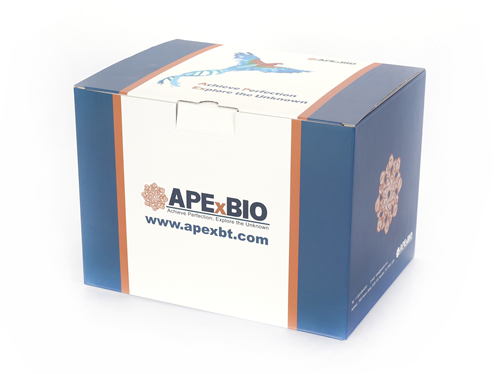- Home
- Signaling Pathways
- Membrane Transporter/Ion Channel
- Calcium Channel
- Autocamtide-2-related inhibitory peptide
Autocamtide-2-related inhibitory peptide
IC50: 40 nM for CaM-kinase II [1].
Synthetic peptide AIP (autocamtide-2-related inhibitory peptide) is a nonphosphorylatable analog of autocamtide-2, which was identified to be a highly specific and potent inhibitor of calmodulin-dependent protein kinase II (CaM-kinase II, CaMKII). CaMKII is a serine/threonine-specific protein kinase, which is modulated by the Ca2+/calmodulin.
In vitro: AIP (1 mM) completely inhibited CaMKII activity, but did not affect cAMP-dependent protein kinase, calmodulin-dependent protein kinase IV and protein kinase C,. The inhibition was noncompetitive, and the action was caused by binding to the autophosphorylation site, which is distinc from that for the exogenous substrate. The IC50 for the autophosphorylation of CaM II is 100 nM [1].
In vivo: Mice treated with AIP by transgenic expression of AIP, were protected from fructose-rich diet-induced arrhythmogenesis, spontaneous contractions and spontaneous Ca2+ release events [2]. Intra-nucleus accumbens (NAc) injection of AIP could dose-dependently increase the HWL (hindpaw withdrawal latency) to noxious thermal and mechanical stimulation in rats with mononeuropathy [3].
Clinical trial: So far, no clinical study has been conducted.
References:
[1] Ishida A1, Kameshita I, Okuno S, Kitani T, Fujisawa H. A novel highly specific and potent inhibitor of calmodulin-dependent protein kinase II. Biochem Biophys Res Commun. 1995 Jul 26;212(3):806-12.
[2] Sommese L, Valverde CA, Blanco P, Castro MC, Rueda OV, Kaetzel M, Dedman J, Anderson ME, Mattiazzi A, Palomeque J. Ryanodine receptor phosphorylation by CaMKII promotes spontaneous Ca(2+) release events in a rodent model of early stage diabetes: The arrhythmogenic substrate. Int J Cardiol. 2016 Jan 1;202:394-406.
[3] Bian H, Yu LC. Intra-nucleus accumbens administration of the calcium/calmodulin-dependent protein kinase II inhibitor AIP induced antinociception in rats with mononeuropathy. Neurosci Lett. 2015 Jul 10;599:129-32.
| Physical Appearance | A crystalline solid |
| Storage | Desiccate at -20°C |
| M.Wt | 1497.77 |
| Cas No. | 167114-91-2 |
| Formula | C64H116N22O19 |
| Solubility | ≥40.2 mg/mL in DMSO; insoluble in EtOH; ≥45.7 mg/mL in H2O |
| Chemical Name | (2S,5S,8S,11S,14S,17S)-8-(carboxymethyl)-17-((2S,5S,8S,11S,14S,17S,20S)-20,24-diamino-2-(3-amino-3-oxopropyl)-17-(4-aminobutyl)-5,8-bis(3-guanidinopropyl)-11-isobutyl-14-methyl-4,7,10,13,16,19-hexaoxo-3,6,9,12,15,18-hexaazatetracosanamido)-2-isobutyl-11-i |
| SDF | Download SDF |
| Canonical SMILES | [H]N[C@H](C(N[C@H](C(N[C@H](C(N[C@H](C(N[C@H](C(N[C@H](C(N[C@H](C(N[C@H](C(N[C@H](C(N[C@H](C(N[C@H](C(N[C@H](C(N[C@H](C(O)=O)CC(C)C)=O)C)=O)CC(O)=O)=O)C(C)C)=O)C)=O)CCC(O)=O)=O)CCC(N)=O)=O)CCCNC(N)=N)=O)CCCNC(N)=N)=O)CC(C)C)=O)C)=O)CCCCN)=O)CCCCN |
| Shipping Condition | Small Molecules with Blue Ice, Modified Nucleotides with Dry Ice. |
| General tips | We do not recommend long-term storage for the solution, please use it up soon. |
Quality Control & MSDS
- View current batch:
Chemical structure








